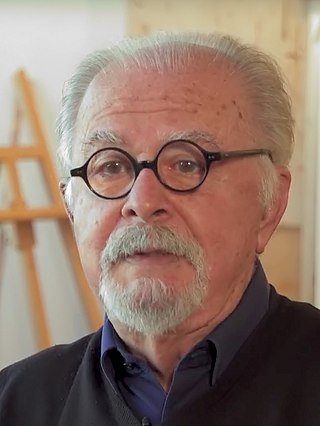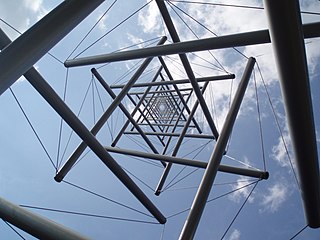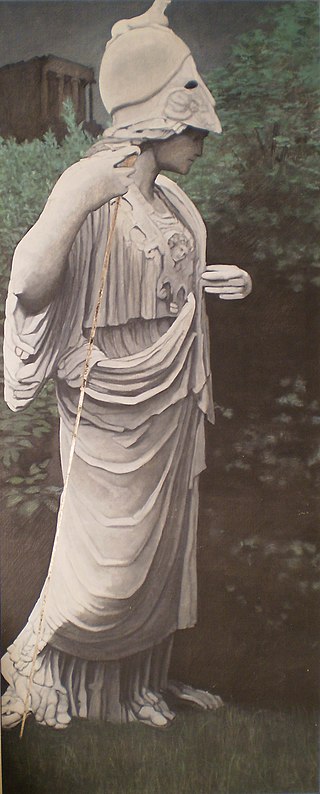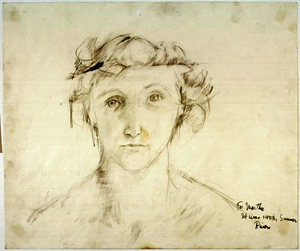Related Research Articles

Fernando Botero Angulo was a Colombian figurative artist and sculptor. His signature style, also known as "Boterismo", depicts people and figures in large, exaggerated volume, which can represent political criticism or humor, depending on the piece. He was considered the most recognized and quoted artist from Latin America in his lifetime, and his art can be found in highly visible places around the world, such as Park Avenue in New York City and the Champs-Élysées in Paris, at different times.

The Hirshhorn Museum and Sculpture Garden is an art museum beside the National Mall in Washington, D.C., United States. The museum was initially endowed during the 1960s with the permanent art collection of Joseph H. Hirshhorn. It was designed by architect Gordon Bunshaft and is part of the Smithsonian Institution. It was conceived as the United States' museum of contemporary and modern art and currently focuses its collection-building and exhibition-planning mainly on the post–World War II period, with particular emphasis on art made during the last 50 years.

Kenneth Duane Snelson was an American contemporary sculptor and photographer. His sculptural works are composed of flexible and rigid components arranged according to the idea of 'tensegrity'. Snelson preferred the descriptive term floating compression.
Sherrie Levine is an American photographer, painter, and conceptual artist. Some of her work consists of exact photographic reproductions of the work of other photographers such as Walker Evans, Eliot Porter and Edward Weston.

Kelly Richardson is a Canadian artist working with digital technologies to create hyper-real landscapes. She is currently a professor at the Department of Visual Arts of the University of Victoria.
Jim Hodges is a New York-based installation artist. He is known for his mixed-media sculptures and collages that involve delicate artificial flowers, mirrors, chains as spiderwebs, and cut-up jeans.
Robert H. Colescott was an American painter. He is known for satirical genre and crowd subjects, often conveying his exuberant, comical, or bitter reflections on being African American. He studied with Fernand Léger in Paris. Colescott's work is in many major public collections, including those of the Museum of Modern Art in New York, the Corcoran Gallery of Art, the San Francisco Museum of Modern Art, the Museum of Fine Arts, Boston, the Hirshhorn Museum and Sculpture Garden, the Baltimore Museum of Art and the Crystal Bridges Museum of American Art.

Susan Charna Rothenberg was an American contemporary painter, printmaker, sculptor, and draughtswoman. She became known as an artist through her iconic images of the horse, which synthesized the opposing forces of abstraction and representation.

Chryssa Vardea-Mavromichali was a Greek American artist who worked in a wide variety of media. An American art pioneer in light art and luminist sculpture, known for her neon, steel, aluminum and acrylic glass installations, she always used the mononym Chryssa professionally. She worked from the mid-1950s in New York City studios and worked since 1992 in the studio she established in Neos Kosmos, Athens, Greece.

Rosalyn Drexler is an American visual artist, novelist, Obie Award-winning playwright, and Emmy Award-winning screenwriter, and former professional wrestler. Although she has had a polymathic career, Drexler is perhaps best known for her pop art paintings and as the author of the novelization of the film Rocky, under the pseudonym Julia Sorel. Drexler currently lives and works in New York City, New York.

Paul Feeley was an artist and director of the Art Department at Bennington College during the 1950s and early 1960s.

Robert H. Hudson is an American visual artist. He is known for his funk art assemblage metal sculptures, but he has also worked in painting and printmaking.

Edward Dugmore was an abstract expressionist painter with close ties to both the San Francisco and New York art worlds in the post-war era following World War II. Since 1950 he had more than two dozen solo exhibitions of his paintings in galleries across the United States. His paintings have been seen in hundreds of group exhibitions over the years.
Peter Grippe was an American sculptor, printmaker, and painter. As a sculptor, he worked in bronze, terracotta, wire, plaster, and found objects. His "Monument to Hiroshima" series (1963) used found objects cast in bronze sculptures to evoke the chaotic humanity of the Japanese city after its incineration by atomic bomb. Other Grippe Surrealist sculptural works address less warlike themes, including that of city life. However, his expertise extended beyond sculpture to ink drawings, watercolor painting, and printmaking (intaglio). He joined and later directed Atelier 17, the intaglio studio founded in London and moved to New York at the beginning of World War II by its founder, Stanley William Hayter. Today, Grippe's 21 Etchings and Poems, a part of the permanent collection at the Davis Museum and Cultural Center at Wellesley College in Wellesley, Massachusetts, is available as part of the museum's virtual collection.
Are Years What? is a sculpture by American artist Mark di Suvero. It is in the collection of the Hirshhorn Museum and Sculpture Garden, in Washington, D.C., United States. The sculpture is named after poet Marianne Moore's "What Are Years". From May 22, 2013 through May 26, 2014, the sculpture resided temporarily in San Francisco, as part of the San Francisco Museum of Modern Art's Mark di Suvero exhibition at Crissy Field.

Marcia Marcus is an American figurative painter of portraits, self-portraits, still life, and landscape.
Tam Van Tran is a visual artist born in Vietnam who lives and works in Los Angeles, California. His primary materials for paintings and sculptures include clay and paper, and extend to chlorophyll, glass, algae, staples, crushed eggshells, Wite-out eraser liquid, beet juice, gelatin, and other diverse ingredients which lend texture and intricacy to his organically-molded abstractions.

Martha Jackson was an American art dealer, gallery owner, and collector. Her New York City based Martha Jackson Gallery, founded in 1953, was groundbreaking in its representation of women and international artists, and in establishing the op art movement.
Cathleen Chaffee is an American curator, writer, and art historian specializing in contemporary art. She currently serves as the chief curator of the Buffalo AKG Art Museum in Buffalo, New York, where she joined in January 2014.
References
- ↑ Heller, Jules; Heller, Nancy G. (19 December 2013). North American Women Artists of the Twentieth Century: A Biographical Dictionary. Routledge. ISBN 9781135638825 . Retrieved 23 January 2022.
- ↑ "Susan Crile - Biography". AskArt. Retrieved 22 January 2022.
- ↑ "Susan Crile". Bennington College. Retrieved 22 January 2022.
- ↑ "Oral history interview with Susan Crile | Collection |". Smithsonian Online Virtual Archives. Archives of American Art. Retrieved 22 January 2022.
- ↑ "Some Living American Women Artists/Last Supper". Smithsonian American Art Museum. Retrieved 22 January 2022.
- ↑ Scott, Andrea K. (13 October 2006). "Art in REview; Susan Crile -- Abu Ghraib: Abuse of Power". The New York Times. Retrieved 22 January 2022.
- ↑ "Susan Crile". Albright-Knox. Retrieved 23 January 2022.
- ↑ "All the King's Men". Metropolitan Museum of Art. Retrieved 22 January 2022.
- ↑ "Susan Crile". Phillips Collection. Retrieved 22 January 2022.
- ↑ "Renvers on Two Tracks". Brooklyn Museum. Retrieved 22 January 2022.
- ↑ "hirshhorn.si.edu". Archived from the original on 2007-07-21.
- ↑ "clevelandart.org". Archived from the original on 2007-09-27.
- ↑ "Susan Crile Produces Artwork on Prisoner Brutality". fairfieldmirror.com. 22 February 2017.
- Dreikausen, Margret, "Aerial Perception: The Earth as Seen from Aircraft and Spacecraft and Its Influence on Contemporary Art" (Associated University Presses: Cranbury, NJ; London, England; Mississauga, Ontario: 1985) ISBN 0-87982-040-3
- Frank, Elizabeth; Susan Crile; Cleveland Center for Contemporary Art (Museum of Contemporary Art Cleveland). Susan Crile, recent paintings : an exhibition (Cleveland, Ohio: The Center, 1984) OCLC 11441511